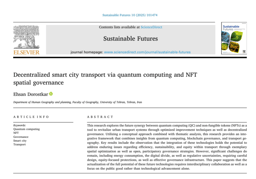Urban Human Mobility and Energy: Shaping Sustainable Cities of Tomorrow
Published in Social Sciences and Earth & Environment

Rapid urbanization has amplified challenges like energy strain, environmental stress, and social inequality all critical to urban quality of life. In our recent book chapter, Urban Human Mobility and Energy (Taylor & Francis, 2025), we dissect how human mobility patterns and energy systems intertwine in cities. Here’s a glimpse into key insights and pathways for resilient, smart urban futures.
Why Mobility and Energy Matter
Human mobility drives energy demand. Transportation networks, infrastructure design, and daily commutes directly impact emissions, grid resilience, and socioeconomic equity. As cities swell hosting 70% of humanity by 2050 (World Bank) integrating sustainability into mobility becomes non-negotiable.
Tech Innovations Redefining Cities
1. Smart Electric Vehicles (EVs)
EVs and hybrids cut emissions but need intelligent energy management. Optimizing speed profiles, battery usage, and grid integration can slash energy use by 30% (Du et al., 2024). Autonomous EVs, powered by LiDAR and AI, will further revolutionize efficiency.
2. Renewables in Transport
-
Solar: PV panels on vehicles/solar-powered charging stations (Yap et al., 2022).
-
Kinetic Recovery (KERS): Harvesting braking energy (Qiu & Wang, 2016).
-
Biofuels: Converting waste into biodiesel/biogas (Awogbemi et al., 2021).
3. Smart Grids & Energy Management
Real-time data balances supply/demand. Regional priorities differ:
-
U.S.: Grid reliability
-
Europe: Renewable integration
-
China: System stability
4. IoT & Smart Infrastructure
Barcelona’s IoT-driven LED streetlights adjust brightness using traffic, weather, and pedestrian data. They also manage EV charging and public Wi-Fi—showcasing how interconnected systems optimize energy and mobility (Visconti et al., 2022).
Key Factors Influencing Urban Energy Use
| Factor | Impact |
|---|---|
| Urban Design | Solar-integrated buildings; climate-responsive infrastructure |
| Population Density | Demand for compact, tech-balanced "holistic smart cities" |
| Socioeconomics | Equity in service access; COVID-era digitalization (e-health, remote work) |
| Policy Gaps | Developing nations struggle with clean energy transition costs |
Future Trajectories
-
Self-Driving Cars & Green Hydrogen: These will enable multidimensional energy optimization and "thinking cities" that adapt to real-time needs.
-
AI/Robotics Integration: Smart traffic management and predictive analytics will reduce congestion—but also escalate energy demands, requiring proactive governance.
Strategies for Sustainable Mobility
-
Engage Citizens: Co-create energy-saving initiatives.
-
Economic Incentives: Subsidies for low-energy mobility (e.g., EV tax breaks).
-
Cross-Sector Value Chains: Link transport, energy, and data networks.
-
Robust Policies: Decentralize energy grids; prioritize renewables.
The Bottom Line: Sustainable cities demand convergence—of tech, policy, and community action. Mobility and energy are two sides of the same coin.
Question for Readers:
Which innovation smart grids, autonomous vehicles, or renewables holds the most promise for sustainable urban mobility? Share your thoughts below!
READ THE FULL CHAPTER:
Dorostkar, E., Najarsadeghi, M., & Huang, X. (2025). Urban Human Mobility and Energy. In Urban Human Mobility Practices, Analytics, and Strategies for Smart Cities (pp. 74-83). Taylor & Francis. DOI: 10.1201/9781003503262-10






Please sign in or register for FREE
If you are a registered user on Research Communities by Springer Nature, please sign in